Product Description
FROM LUFT46:
"With the increasing Allied bombing of Germany, new methods were needed to bring down the enemy bombers. The methods currently used (antiaircraft guns and fighter aircraft) were somewhat effective, but costly in ammunition and fuel expended, lost pilots and airframes. Thus, the guided antiaircraft (or FLAK) rocket was envisioned. One of these, perhaps the most ambitious, was the Wasserfall (Waterfall), developed at Peenemünde.
The basic body shape had been worked out by early 1943, and was basically the same shape as the larger A-4 (V-2) rocket. Dr. Thiel, who had designed the A-4 rocket engine, designed the Wasserfall rocket engine, and early test models of it were running by March 1943, with a more advanced version being tested later in July 1943. Unfortunately for the Wasserfall program, Dr. Thiel was killed during the British bombing of Peenemünde in August 1943. Since the Wasserfall was to have to stand ready for launching at a moment's notice, and it would have to stay fueled for possibly months on end, the liquid oxygen/alcohol fuel system of the A-4 could not be used. Instead, Visol (vinyl isobutyl ether) and SV-Stoff, or Salbei (90% nitric acid, 10% sulfuric acid) were used hypergolically (automatic ignition when mixed). Pressurized nitrogen was used to force the fuels into the combustion chamber, with rupture discs being fitted between the nitrogen tanks and in the pipelines. Several safety features were incorporated to the Wasserfall launch procedure. One of these was that the rupture disc in the oxidant line was lower than the one in the fuel line, this was to insure that an excess of oxidant was in the combustion chamber first, thus preventing a fuel-rich explosion. Another safety feature was that an explosive starter valve was fitted in the pressurized nitrogen tank, this could be explosively closed to allow the nitrogen to escape into the atmosphere in case combustion did not occur upon firing.
In the first version of the Wasserfall (W-1), the wings were longer and less swept than the later versions. Also, the four wings located at the rocket's mid-body were offset by 45 degrees from the tail fins. This was thought to aid in the prevention of aerodynamic shielding of the steering mechanisms by the wings of the tail fins, but later windtunnel tests proved this unnecessary. The second design, W-5, was slightly larger, and the wings were smaller and sharply swept back. The final version, the W-10, was similar to the W-5 except it was 27% smaller, to help conserve materials which were scarce in the last days of the war."
This model has been scaled to be compatible with most A&A-style games.
